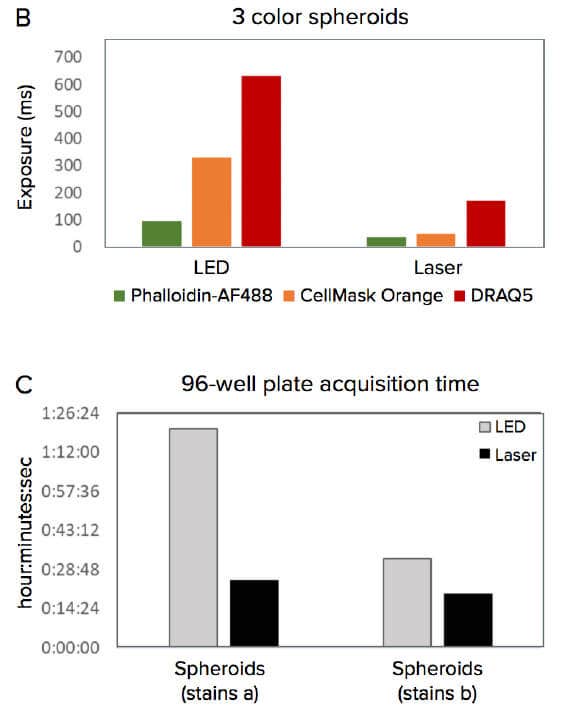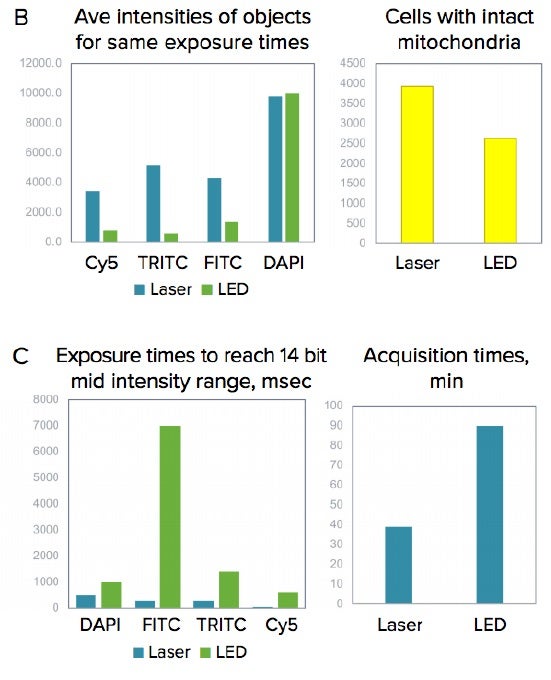
Confocal Microscopy Laser Illumination
High-intensity laser light source for confocal microscopy
Solid state lasers for high-performance laser excitation
With the increasing use of highly-complex cell-based 2D and 3D assays in biologic research, there is a pressing demand for improvements to the capabilities of automated high-content imaging. The ImageXpress® HCS.ai High-Content Screening System is a high-throughput solution that utilizes a 7-channel laser light source with 8 imaging channels to penetrate into deep tissue while reducing exposure times and increasing focus.
The illumination power of the laser light source significantly increases image intensity and assay sensitivity, which is especially important for dim samples. Imaging systems with lasers substantially decrease exposure times, which result in increased imaging speed and assay throughput. 3D imaging especially benefit from the laser light source with higher image intensities and improve image quality, which result in increased assay sensitivity and imaging speed.
**Data and images were acquired using the ImageXpress Confocal HT.ai High-Content Imaging System during development using customer samples. Results may vary. Highlighted features’ price, time to deliver, and specifications will vary based on mutually agreed technical requirements. Solution requirements may cause adjustment to standard performance.
AgileOptix technology with powerful, solid state light engine
AgileOptix technology makes it possible for the system to deliver the sensitivity and throughput needed for demanding applications by combining an advanced solid-state light engine with seven laser lines and eight filter combinations, proprietary spinning disk technology, state-of-the-art optics, and a scientific CMOS sensor.
Molecular Devices can successfully tailor the ImageXpress HCS.ai system to include customized software and hardware including the features described herein, as well as integration of other lab components such as incubators, liquid handlers, and robotics for a fully automated work cell. Check out our new Organoid Innovation Center where we showcase these cutting-edge technologies with novel 3D biology methods to address key challenges of scaling complex 3D biology.
Sales are subject to our Custom Product Purchase Terms available at www.moleculardevices.com/custom-products-purchase-terms.
Laser and LED light source specifications
The ImageXpress HCS.ai system can be equipped with multiline laser light source with matched filters spanning 405 nm to 730 nm excitation wavelength provides drastically increased illumination power to the sample. Laser light source results in brighter images, increased sensitivity, and increased speed and throughput speed of assays. The impact is especially important for the assays where sensitivity and timing are limiting factors.

Decreased exposure times with laser illumination
Confocal imaging and 3D image analysis are especially useful for capturing the complexity of 3D biological assays like organoids and spheroids. Here, we compared a standard imaging system with LED excitation to one with laser excitation.
Imaging 3D cancer spheroids

A. DRAQ5 and Phalloidin-AF488 overlay of an untreated spheroid plus nuclear segmentation and area masks of the 2D projection image. Low magnification QC of spheroid staining could be used to locate treated and control spheroids in the well for accurate centering before acquiring at a higher magnification. B. Exposure times optimized to acquire images of equivalent brightness. Different exposures were required for different staining protocols. C. Speed of acquiring a 96-well spheroid plate in the ImageXpress Confocal HT.ai system at 20X using LED vs laser light sources.

Imaging 3D lung organoids

A. Confocal image of organoid culture (maximum projection), 10X. B. Images were taken on the ImageXpress Confocal HT.ai system using same exposure times for LED or laser light sources, then cell count and average intensities of objects (cells) shown for representative images. C. Exposure times were matched for 14-bit intensity range for both laser and LED. Optimized exposure times and duration of the experiment were substantially reduced by using lasers.
